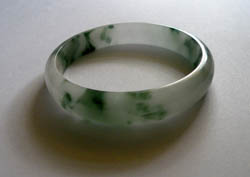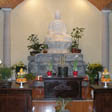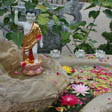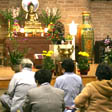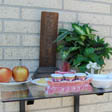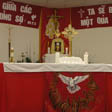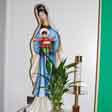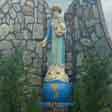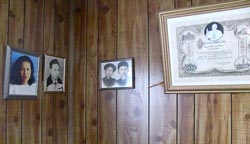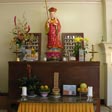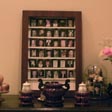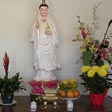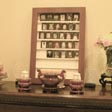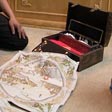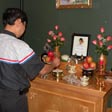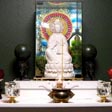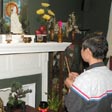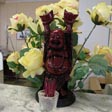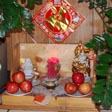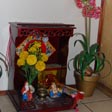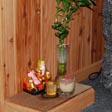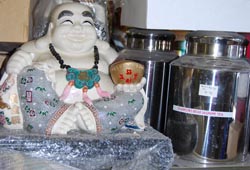Preserving Vietnamese Culture and Language in Southern Louisiana: Altars as Symbols of Identity
By Emma Tomingas-Hatch
The Vietnamese make up a large portion of Louisiana's Asian population today, 44% in fact. They are also the largest immigrant or refugee group in the state. According to the University of Louisiana-Lafayette's Center for Cultural and Eco Tourism, 3,533 live in East Baton Rouge and nearly 850 live in the Vermillion Parish. Other Vietnamese populations are dispersed throughout the state. The largest is in New Orleans with 14,000. Other parishes with Vietnamese communities include Terrebonne, Plaquemines, Lafourche, Caddo, Rapides, Iberia, and St. Bernard. Initially it is jobs that drew the Vietnamese to Louisiana, many arrived as unskilled workers. However, according to the Center for Cultural and Eco Tourism most currently either own their own business or work for Vietnamese-owned operations.
Maintaining Community as Newcomers: The Importance of Language and Religion
Many Vietnamese people in Louisiana came to the United States as refugees. In 1954, the Geneva Agreement divided Vietnam into two parts: the North and South. The North was surrendered to the Communists. At this time, many Vietnamese people living in North Vietnam fled to South Vietnam in order to escape communism. Nearly twenty years later, in 1975, South Vietnam also fell to communism and many people were again forced to flee their homes. Some escaped on fishing boats and many of them came in groups to the United States. Many spent time in army and refugee camps, waiting for sponsors and safety. For many, their religious leaders played an important role in one or both of these flights. According to Joseph Doan, a Vietnamese man who is active in his Catholic community in Abbeville and has lived in Louisiana since 1975, their priests served as their leaders in escaping communism. A lot of the priests could speak English, and they knew where to go and what to do. They had contacts in the United States that provided help for the refugees.

A lot of the refugees spent time in many other states before settling in Louisiana. They were drawn to Louisiana for two main reasons. The first was the employment opportunities in the fishing and shrimping industry. The men were able to find work as fishermen while the women could find employment in the seafood industry working in fish shops. These jobs are similar to the kind of work many of them would have done in their home country. Joseph Doan explains:
The reason they are arriving in Abbeville because ? there is a lot of work for fishermen. The man can work on a boat, go fishing, and the lady can stay at home and work in seafood business; crab picking, you know. They clean crabs and de-head the shrimp.
The second reason the Vietnamese people found themselves in Louisiana was that Vietnamese communities were forming in the state. Many had a friend or a family member already living here. They went where they had contacts and help available to them. The weather in Louisiana is also comparable to the hot and humid climate in Vietnam.
Trust and respect are very important in Vietnamese culture. In Vietnam the people live in groups as a family. "The doors are open," as Joseph Doan describes of the communal life in his home country. People share what they have and help out even when they cannot afford it. American culture focuses on the individual, while Vietnamese culture focuses on the community; many of the people interviewed described this difference as being one of the things that was the hardest to adjust to in the United States.
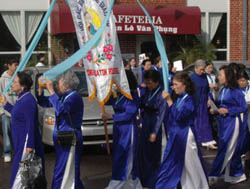
The majority of the southern Louisiana Vietnamese population is from South or Central Vietnam. Some were originally from North Vietnam, but their families migrated south after 1954 when the North fell to communism. In fact, only one person interviewed by this writer even knew someone in south Louisiana from North Vietnam who did not come through South Vietnam. The three main dialects of the Vietnamese language are Northern, Central, and Southern. Thay Dao Quang, the Buddhist monk at Tam Bao Temple, explains that because of the political split in Vietnam, "Even the people that speak the North Vietnamese language in the United States, politically they consider themselves to belong to the South Vietnam government." He goes on to explain that for most Vietnamese immigrants the political strife of their home country is still very real to them in their everyday lives. He explains that most of the Vietnamese people in the United States do not accept the current Vietnamese flag. Instead they hold the flag for Southern Vietnam prior to 1975 as the symbol for their home country.
The three main Vietnamese religious groups in Louisiana are Catholic, Buddhist, and a few Baptists. Their religion is something that unites their communities and plays a role in keeping their culture alive. Thay Dao Quang illustrates this point when he says explicitly that his hope for the Tam Bao Temple in Baton Rouge is that it brings the community together. Joseph Doan elaborates on the importance of community when he says:
Asian people, they want to live in a group. They don't want to be scattered. When they are scattered out like that, they feel unsecured. First of all language is an issue. They don't know exactly the American culture, American custom, so they are scared to live spread out in the community. So they rather live close to each other so when they need something there is help. See in Vietnam, that's how they live. They live very close to each other, helping each other.
The communal aspect of the Vietnamese religious communities in Louisiana plays a large role in the maintenance of their language and their culture. Religious institutions provide a community in which language and culture are top priorities.
Thien Tran, the owner of Cathy's Nails in Lafayette, Louisiana, has lived in Louisiana since 1980. He attends the Vietnamese mass every Sunday at St. Jules Church in Lafayette. One of the things he enjoys the most about the services offered by St. Jules is the children's Vietnamese Sunday school. They help the youth practice their Vietnamese language skills and perform all of the Sunday school activities in Vietnamese. Thus, the children not only learn about their religion in Vietnamese, but also are given the chance to improve. Having a religious service in their native language also works for many of the elderly people who cannot speak English very well. This way they can understand the entire service and take part in all of the aspects of their religion in America.
Joseph Doan explains that, in his experience, church serves the younger generations with a tangible link to their heritage. Many of them go specifically to learn their language and more about their culture. He says, "The younger people who want to learn Vietnamese language, they want to keep their culture, especially the language. ? Wherever you go, I don't care what you do or where you go, you have to keep your roots." His emphasis on "roots" is an important one. People are going to religious services not only for spiritual guidance but also to maintain a link to their "roots." One of the ways to hold onto cultural roots is language.
The Vietnamese communities in southern Louisiana engage in many different cultural activities, and as Joseph Doan pointed out, these are performed in their native language. Language is viewed as perhaps the most important facet of Vietnamese culture in the United States. The Vietnamese in southern Louisiana live in communities where Vietnamese is spoken; they attend religious ceremonies and activities where it is spoken, all in order to preserve their language and their culture. Joseph Doan emphasizes that "in order to preserve your culture, you have to learn the language. So that's the reason that we live in a community, to help out each other. When we do an activity together, either religious or just social, it's in our language so we can keep it up." Along with their separate religious celebrations both the Buddhist and the Catholic communities also observe specific Vietnamese holidays. One holiday in particular that both the Catholic and the Buddhist communities celebrate is the Lunar New Year, known as Tet. Both communities have similar traditions related to this event. They light fireworks, perform recitals, watch dragons dancing, and eat traditional New Year foods.

The most important aspect of the New Year, and other Vietnamese holidays, for community members is that partaking in these events provides another link to their heritage and works for the preservation of their culture. Children learn about their Vietnamese customs by participating in the celebration. Joseph Doan discusses the New Year celebration in the Vietnamese Catholic community in Abbeville and an important purpose that it serves. He says, "We celebrate every year here in Abbeville to let the children know the custom of Vietnam, the culture of Vietnam." The children in the community grow up constantly being exposed to their Vietnamese culture so they will be able to do the same thing for their children in the future.
Jade: A Cultural Symbol
For the Vietnamese in southern Louisiana the main way to maintain their culture is simply to live it. Their communal life keeps their language and culture alive. Other simpler ways of maintaining Vietnamese culture include examples such as women wearing a simple jade bracelet on the left wrist for good luck. The women believe that the jade keeps negative thoughts/wishes/spirits/luck away from the wearer. Over time the jade can deepen in color and, to some, a darker green symbolizes inner strength and good luck.
Some believe that if the bracelet breaks it is very bad luck. Many women who do not wear one every day confess to owning one but wanting to keep it out of harm's way. Julie Nguyen, who has lived in Louisiana for 17 years and owns Dynasty Nails in Baton Rouge, has a jade bracelet that she leaves at home for two reasons. The first and most important reason is because her bracelet is a family heirloom. Her father gave it to her mother on their wedding day. The second is because she believes that if the bracelet breaks it is very bad luck. She will wear it for very special occasions, but mostly she chooses to keep it safe at home. Some Vietnamese men have a similar tradition of wearing a jade ring or necklace with a jade pendant, but these items are not nearly as common as the women's jade bracelet.
Altars: Public and Private, Catholic and Buddhist
Individuals also work to keep their culture alive through the use of public and private religious observances, specifically, public and private altars. This tradition is prevalent in both the Vietnamese Catholic and Buddhist practices. Both religions traditionally have a main altar in their worship center. They also have traditions of maintaining home altars. The Vietnamese, both Catholic and Buddhist, have two kinds of home altars: one is dedicated to general worship and the other is specifically dedicated to their ancestors.
Thay Dao Quang, the Buddhist monk at Tam Bao Temple, believes that the use of home ancestor altars stem from the tradition of Confucianism. Confucianism was widespread in China until 1912; because of Vietnam's proximity to China they share a lot of similar traditions. One common Confucian practice is ancestor worship, which can still be seen in the culture today.
Buddhist Home Altars and Ancestor Altars
Catholic and Buddhist home ancestor altars are similar. Both are adorned with pictures of deceased family members, and both are located in a central part of the home. Usually the Catholic ancestor altar is directly underneath the main religious altar in the home. It is a little smaller than the main altar and adorned with pictures of deceased family members, there are usually candles and artificial flowers. The home altar documented for this project was a little different. With no room for it in its traditional space, the family dedicated a corner of the family room for the altar. There they hung pictures of family members that had passed.
When the anniversary of a family member's death occurs, a special ritual is held, the priest performs a special mass for the deceased and small offerings are made. At home, depending on the individual traditions of the family, candles and/or incense is lit and the entire family says a special prayer together. The prayer and specifically stating the family member's name throughout the prayer are important parts of the ritual; otherwise, it is believed that another soul is able to receive the prayer, and it would not get to the intended spirit. Candles are lit and fresh flowers, usually white or yellow carnations, are placed on the altar to honor the family member. Joseph Doan states that on the anniversary of his father's death, he always lights two candles and lets them burn the entire day. Similarly, Tony Bui, an altar attendant at St. Jules Church, lights the altar candles to honor his ancestors.
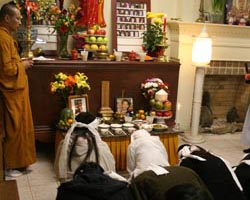
Buddhist ancestor altars differ from the Catholic ones in many ways. The Buddhist altar is divided into in two parts. One side is reserved for male ancestors and the other for female ancestors. Like Catholic altars, they are traditionally adorned with pictures, holy water, candles, incense, flowers, and lights, also include offerings of food. Thay Dao Quang explains the significance of these objects on the ancestor altar at Tam Bao Temple:
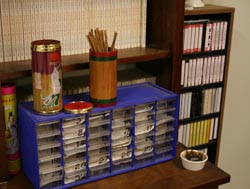
When you burn the incense you offer your virtue; your goodness, kindness compassion, to the Buddha or to your ancestors. If you pay attention, the incense gets shorter and shorter and shorter. When you look at the incense burning, you should remind yourself, life is shorter and shorter and shorter. So we have to treasure every moment we're still alive. The Holy Water in the small urn, it stands for morality, for your virtue, for your compassion, for your patience. Flowers symbolize the beauty of nature, the beauty of humans, but these decay. Same thing with human life. We look young, we look beautiful; but in the next fifty years, you will look different. It is a reminder that everything is changing moment by moment. We want to make the beauty last forever, but the reality is that everything is changing moment by moment. The lights symbolize wisdom. The candles and the lamp stand for wisdom. [In] Buddhist philosophy, we strongly believe that only wisdom can shine into the darkest places. ? Your wisdom will stay with you from this life to the next life. The food stands for nutrition. Everyone needs nutrition. We offer nutrition to the ancestor and the way we treat them is as if they were still alive. That is how we show that we respect the people, even the ones that have died.
Many objects on the Buddhist ancestor altar serve as reminders of how fragile life is and how each moment should be cherished. The Buddhists also make offerings of food and drink to their ancestors on a regular basis. Ton Dinh, a parishioner of Tam Bao Temple is originally from Central Vietnam and has lived in Louisiana for 15 years. He describes his ancestor altar and the traditions that he follows since his wife passed away about a year ago his ancestor altar is dedicated primarily to her.
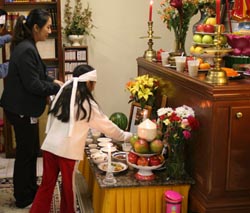
It is next to his Buddhist altar in the family room of the home he shares with his young son in Baton Rouge. In the center is a photo of his wife, on both sides are pink flowers and in front are candles and incense. He built the altar himself. He explains that this is not necessarily typical and everyone does it differently: "I wanted to make something for my wife. I have money. I can buy everything but I don't want to do that. I wanted to make it for her." Next to the altar is a wooden plaque with golden Vietnamese writing. Ton translates it: "I can go anywhere in the world, and I would never find anyone like my wife."
Also on the altar is a CD recording of her funeral service and her Buddhist prayer beads are next to her picture on the altar. A candle in the shape of a coconut is from his wife's sister and there are also small glass bowls containing holy water. The bottom of the altar is hollow and inside is a box that contains some of his wife's personal belongings. Ton plans for his son to keep the box forever; and anytime his son has questions about his mother, they can go through the box together.
Whenever Ton cooks, he is always sure to make enough for his wife and if he has not cooked anything that day he usually puts fruit on her altar. He tries to keep the incense burning all day if possible. Every evening when he gets home from work, he and his son pray in front of the altars. Ton performs the ritual first and his son second. It is tradition to pray in front of the Buddhist altar first and then the ancestor altar second. For the ancestor altar, a stick of incense is lit. Ton holds it in his hands in a prayer position. He bows twice, once for the life his wife, or ancestors, lived; and once for her death. Then he puts the incense in the small bowl of sand at the front and center of the altar.
If he and his son get home at different times, then they often perform the ritual separately. Besides the evening tradition, Ton lights incense for Buddha every morning and as often as he can for his wife. He also explains that his son often prays in front of his mother's altar when he is upset or simply is in need of his mom. And he usually finds himself praying in front of his wife's altar multiple times throughout the day.
The Buddhist altar is in the center of the far wall of Ton's living room. It is adorned with objects similar to those on the ancestor altar: flowers, holy water, incense, candles, and lamps. These objects have] the same symbolic meaning on both altars. In the center is a large statue of Buddha and on both sides of the statue are yellow flowers. Ton explains that yellow is the color of Buddha. For special occasions, Buddhists, like Catholics, usually replace the artificial flowers with real ones on both the ancestor and the religious altars, and light the candles. The small bowls of water symbolize life; everything needs water in order to live. In the front center of the Buddhist altar is a small bowl with burnt sticks of incense in the sand. Unlike his ancestor altar, Ton does not offer food on the Buddhist altar. On both altars he leaves the lamps on all the time. Ton lights a stick of incense and holds it between his hands as if praying, he then bows three times, once for the Buddha, once for the Dharma (the Buddhist doctrine), and once for the Sangha (the Buddhist community). The incense is then placed straight up in the sand.
Altars in Businesses
This same prayer ritual is observed for all Vietnamese Buddhist altars, including the smaller ones that people keep in their businesses. In her nail salon, Dynasty Nails, Julie Nguyen and her family have a small Buddhist altar on a shelf near the waiting area in the front of the store. It consists of a medium sized "Lucky Buddha" statue and a small bowl filled with sand to hold incense. The lucky or happy Buddha is a common image of Buddha.
Every morning before the Nguyen's open the nail salon, they light the incense and offer hot tea to the Buddha on the altar. As an offering, they will place on the altar whatever they have available that day. The offerings are cleaned up whenever Julie or her daughter can find a spare minute throughout the business day. Prayers are said at the altar in the same fashion. Whenever any of the employees has time, they will say a prayer and, depending on how the day is going, their prayers will be about different things such as health, profit, safety, etc.
Catholic Home Altars
Buddhist prayers said before home altars are similar in their subjects and concerns to those of the Catholic prayers. Many Catholics describe the ritual prayers said in front of the altar as depending on what has happened throughout that day. The Catholic altars are usually in the main room of the house. In the center is a statue or a picture of Jesus, and next to him are statues or pictures of Mary and Joseph. Candles, flowers, and holy water adorn the altar. Some families have other special items on the altar as well, such as a picture of a Vietnamese martyr or a special vial of holy water.
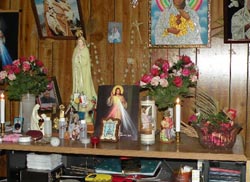
Every day the entire family prays together, usually reciting in unison, and then, in some families, individual prayers are said. Many Vietnamese Catholics pray before bedtime. Thien Tran describes his family's prayer ritual. His family only lights the candles for special occasions, such as a holiday, the anniversary of the death of a family member, or a visit by a priest who comes to the home to say mass. He, his wife, and their three young children gather in the family room before bedtime and sit in front of the altar. His wife then says a prayer, and they all follow. Bac Nguyen, a friend of Thien's from South Vietnam who has lived in Louisiana since 1988, has a similar ritual with his family's altar. They, too, sit together before bedtime and recite a prayer together every night. One difference between Bac's and Thien's ritual is that Bac's family lights the candles every night for their prayer. Joseph Doan's family prayer ritual differs only in that they pray three times a day: once in the morning, once before dinner, and once before bed.
For Tony Bui the items on his Catholic home altar are sacred, especially the statues, pictures, and holy water because these things have been blessed by a priest. He notes how much respect they have for their statues of Jesus, Mary, and Joseph. In Abbeville a special statue of Mary is weekly given to a different family to place on their altar. This, in Abbeville, constitutes a special occasion: candles are lit and fresh flowers, traditionally red roses, are bought for the altar. During mass that week the priest says a special prayer for the family possessing the statue. The family makes offerings of wine, bread, and money in church. After mass, the entire community gathers at the family's home and they all pray together in front of the statue. To be selected to temporarily have the statue is a great privilege among the Catholic Vietnamese community in Abbeville.
Many of the Catholics who were interviewed distinguished themselves from the Buddhists in a couple of ways. The first was that it is primarily a Buddhist trait to have an altar in the place of business. Many Catholics adorn their places of business with paintings and statues of Jesus or Mary, but do not have altars. Nonetheless, these items function in a similar way as the Buddhist business altars do, in that they are reminders of beliefs and spirituality. Another distinction between the altar practices of the two religions is that of offerings on the altar. As previously mentioned, the Buddhists traditionally make offerings of food and drink on their altars.
Depending on the occasion or on what is available, they usually make it a point to offer something every day. The Catholics, on the other hand, usually "only offer their prayers" as Tony Bui stated. Another distinction that was often made was the issue of incense on the altar. Many Catholics explain that incense was not something they put on their altars, but they were aware that it was a Buddhist tradition to burn incense on the altar. However, some Catholics point out that recently the Vatican made the decision to allow the Vietnamese parishioners to burn incense on their home altars and consequently a few Catholics do currently participate in the tradition of burning incense. The final distinction is bowing. Buddhist traditionally bow from their waist three times in front of their altars, while Catholics simply bow their heads during prayer.
Conclusion
Despite the differences, there are many similarities in the ways that the Catholic and the Buddhist communities in Abbeville, Lafayette, and Baton Rouge keep their culture and religions alive and both seem to have a similar goal of maintaining all of their Vietnamese traditions in Louisiana for generations to come.
Notes
For more essays on the Vietnamese in Louisiana, see Offerings to Kings and Buddha: Vietnamese Ritual Activities at Chua Bo De: The Vietnamese Buddhist Community in New Orleans Area and Tet, the Vietnamese New Year, in the New Orleans Vietnamese Community.


